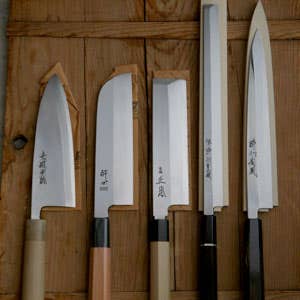
Five Principal Styles Of Japanese Knife
The manufacture of highly specialized cooking knives in Japan became widespread in the 16th century, when blacksmiths working for members of Japan's noble soldier class, the samurai, competed against one another to create the best swords and knives. Eventually, as different regional cuisines began to develop across Japan, merchants began learning the craft. In the east, where more-rustic cooking methods reigned, stout and functional straight blades were predominant; in the west, more-delicate, pointed styles found favor. Hand-forged Japanese knives, the best of which are fabricated in the city of Sakai, are usually made in one of five different styles.
1. The knife known as kamagata usuba originated in Osaka and has a distinctively curved tip suited to intricate vegetable-carving methods, as well as juliennes. The kamagata usuba shown has a handle of Japanese yew, an evergreen native to Japan, and—a rarity among old-style Japanese knives—a blade of stainless steel.
2. Less delicate kitchen tasks like butchering poultry and breaking down whole fish traditionally call for a deba, which has a broad, wedge-shaped blade that can easily cut through bone and cartilage.
3. The usuba, originally from Tokyo, is considered the most versatile of traditional Japanese knives; its sturdy, wide blade is well designed for slicing vegetables. The usuba is the preferred tool for katsuramuki, the technique of cutting vegetables (like daikon and cucumber) into paper-thin sheets and scrolls. The usuba shown is made of carbon steel; its handle, attached to a buffalo horn collar, was carved from magnolia wood.
4. The takobiki, also developed in Tokyo, is customarily used for preparing sashimi and, especially, octopus. The type of knife shown is called a suminagashi takobiki, which is distinguished by an elegant wave pattern on the blade, a result of a special forging process.
5. Used mainly in the preparation of sushi and sashimi, the venerated yanagi has a thin, elongated blade and a slightly curved tip that make it ideal for producing paper-thin slices from fish filets. The yanagi shown was forged by the master blacksmith Keijiro Doi in Sakai and has a core of carbon steel fused to an iron jacket; a piece of carved water buffalo horn attaches the blade to the ebony handle.
Keep Reading
Continue to Next Story










